Hello, below is one of my favorite posts from my archive, which first went out a year ago. If you’ve joined recently, are looking for some gothic November vibes, and/or want to relive our adventure exploring the bowels of an abandoned 19th-century mountain fort, this repost is for you. Plus, I’ve now added a voiceover.
(Plant post incoming soon thereafter!)
It’s All Saint’s Day. The sky is a moody gray and the trees are restless. You’ve just made the ascent, steep and slick with leaves, to the wooded hilltop that was once a crossroads of four ancient fiefdoms. You’ve come to see the fort. The abandoned one.
Though you’ve already made the decision to come, you will have more decisions to make. Here is the first: blaring red signs hung on the trees at a wide bend in the road, declaring, “Propriété privée, Défense d’entrer, Danger.” Do you ignore them?
Okay, so does everyone; the road is unbarred, even inviting in its broadness. As you stroll on, you see rough stone walls threading through the vegetation, and where pillars mark the entrance to the fort, layers of sturdy wire fencing. But you keep walking, and around the corner is another bridge over the ditch, with a fence wrenched all the way to the ground. It will be easy to step over, the sheet-metal sign that once warned people away now a convenient steppingstone across the chain-link. Do you take the step?
That wasn’t so hard. Now you’re faced with a wooden walkway, boards broken in and dangling. At the end, one of the metal gates is swung wide open, further unhinging the face of a graffitied clown. Somewhere a magpie is grating at the air. Thoughts?
Turns out the bridge is undergirded by solid concrete, and the ditch is shallow here. You’re in. The gateway has given onto a kind of courtyard, rangy with saplings, ivy, wooden pallets, loose barricade tape, and skewed fencing and chicken wire. Here is the first wide passageway of brick-arched doorways and windows in the mortared limestone walls to try your daring. The barriers range from chicken wire to padlocked iron doors, but in the first narrow doorway, a corner of the chicken wire has been peeled back. Do you crouch through and wander the bare, crumbling, graffitied rooms inside?
What about later, deeper into the tangle of green and stone, when you find an obscure entrance crossed with leaning timbers, and beyond it only blackness? You have a headlamp—and, by the way, friends. What about the opening at the back of that dark vaulted-ceiling casemate? It may be nothing more than an alcove, but if not…how far do you go?
All right, enough, I’ll release you from this choose-your-own-adventure and tell you mine.
Exploring the Fort des Quatre Seigneurs was my most adventurous foray yet into the sport of urban exploration, or urbex, a term I learned from the friends who accompanied me on this adventure.1 I’m not naturally a rule-breaker; I don’t generally get a kick out of circumventing authority to enter forbidden spaces. I do, however, have a fascination with abandoned structures that I have a feeling most people share. Why is that?
Some possible explanations: Left off from the near-constant human intervention required to maintain our constructed reality, a place becomes a portal into an alternate dimension of sorts, a liminal dreamscape, an uncanny valley of memento mori and entropy. The familiar is unfamiliarized by decay, an aesthetic that blurs order and chaos, perhaps the same kind of relative chaos that makes nature itself so appealing to us. Outside of our collective power, a place gains an alluring new power of its own by virtue of being beyond us. By becoming unknown and Other.
Then there’s History, of which I’m a fan, and which was the origin of this foray. Old and abandoned places are storied—they have narrative power as well as physical and aesthetic. In the place-based post before this one, I wrote about the ceinture fortifiée de Grenoble, which I had discovered by visiting another of its 19th-century forts, one rescued from abandonment. I was especially enthralled by the story I uncovered about the Fort des Quatres Seigneurs, a story of Resistance heroes and mysterious scientists and depollution pyrotechnique. (Read it here if you haven’t already.) When I saw indications online that, despite its privately owned and decrepit state, the fort is a popular and relatively accessible spot, the idea of visiting took root. The interest of two friends sealed the deal. In numbers, my logic ran, there is safety.
So, yes, on the day after Halloween, we took the hike, ignored the prohibitive signs, stepped over the fence, and crossed the bridge. On the way, we had walked on the road that the Resistance fighter Paul Vallier sped along on his moped with his stash of pencil detonators, only hours ahead of a convoy of German soldiers. Passing archways that peered out of a seemingly natural limestone rockface, I had speculated about whether this was the wing of the fort that Vallier blew up (along with the unlucky Germans). Matthias speculated about whether those crawl spaces would be our best way in.
But, thanks to a previously broken rule of urbex (never create an opening that isn’t already there), getting in was easy.
Now, in the courtyard, we were looking at the front building once repurposed by the Grenoble Center for Nuclear Studies as a laboratory of cryptic purposes. And we went through the chicken wire.
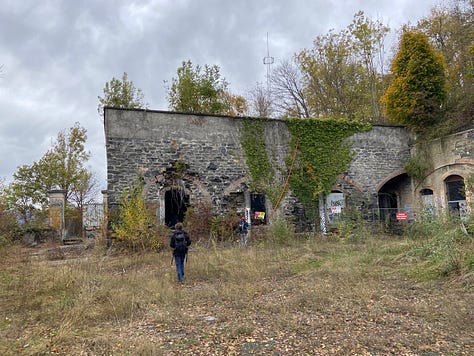
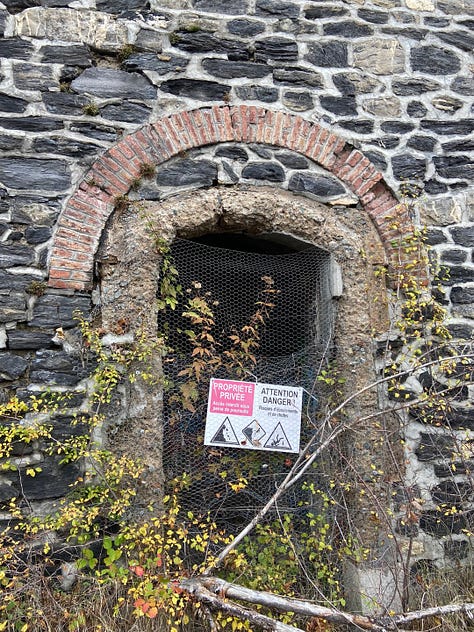
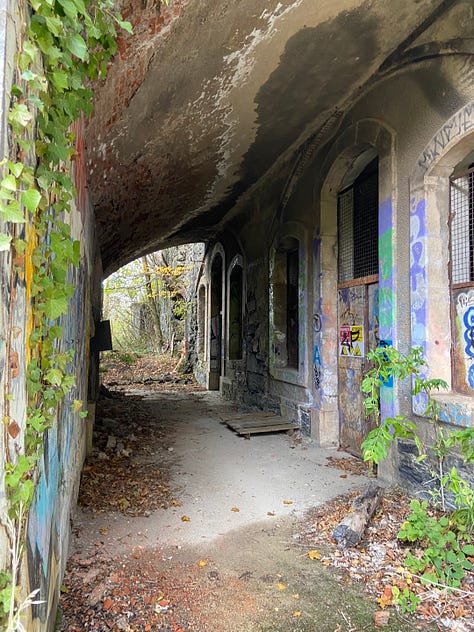
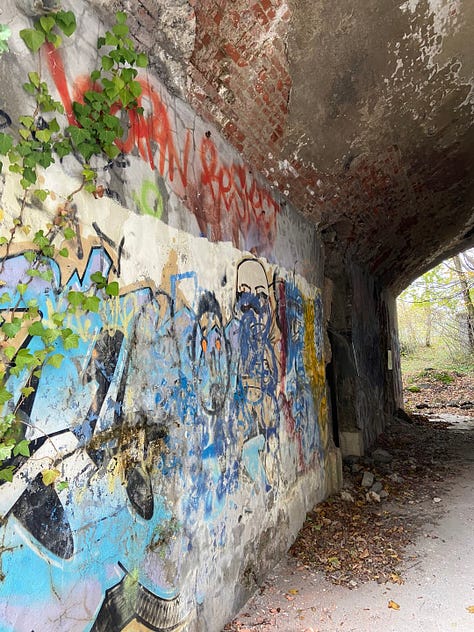
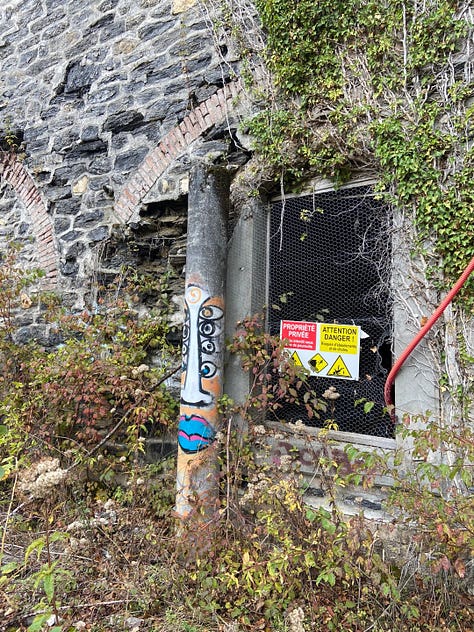

Though the corridor between these rooms was narrow and dim, crumbling windows gave plenty of light into their interiors. The walls were colorfully tagged; I was surprised that none of the tagging looked particularly fresh. There was a dusting of rubble, but no serious collapse, and some stashings of things with still recognizable signs of intent, such as a pile of cut logs, a basin full of stagnant water, and a bright orange plastic hose snaking in from the window, now coated with watercress. In a dark windowless room there were stacks of wooden crates on mounded sand. One crate had a somewhat tautological handwritten paper label, “Pyrotechnis, caisse contreplaqué,” but, clasps rusted shut, otherwise left the contents to the imagination. If not contraband, then leavings of the depollution pyrotechnique, the decades-long process of clearing out old munitions, during which this place was truly interdit.
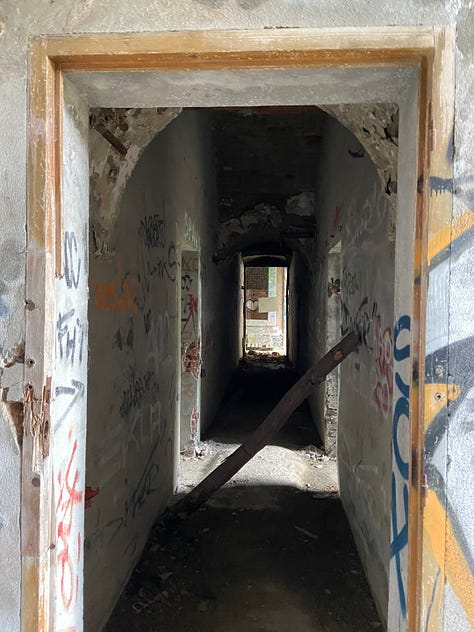
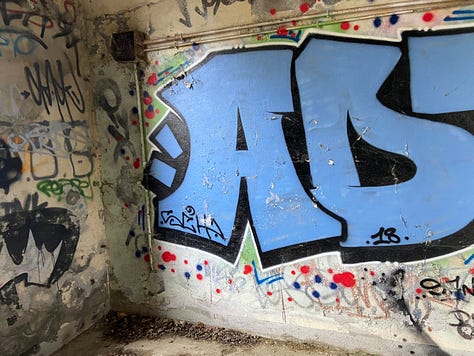
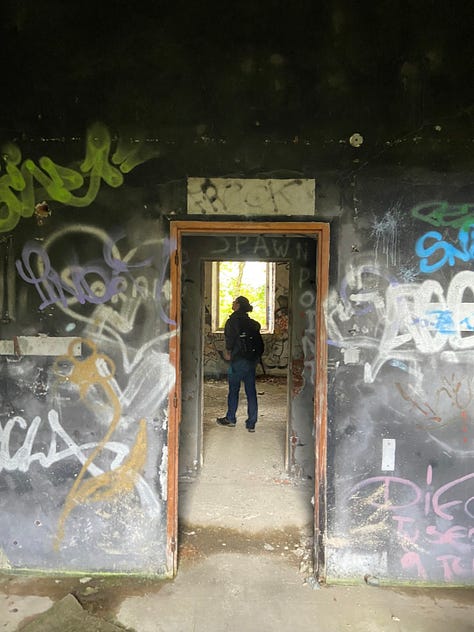
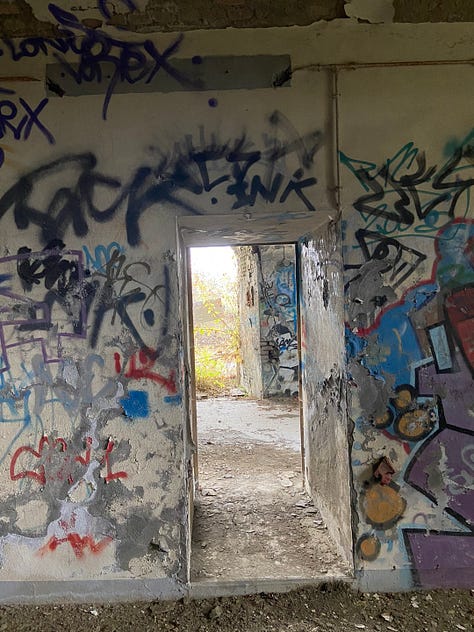
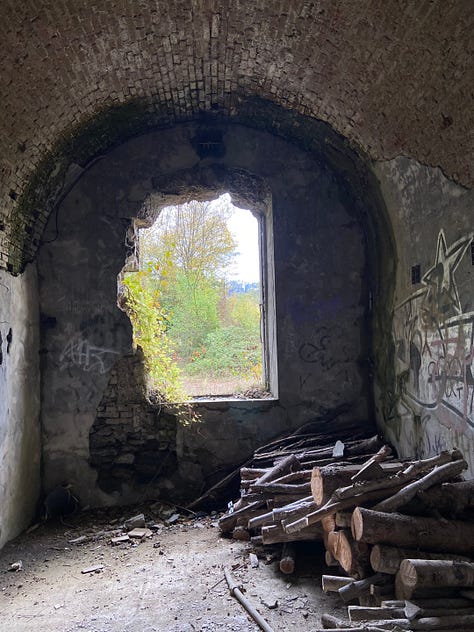
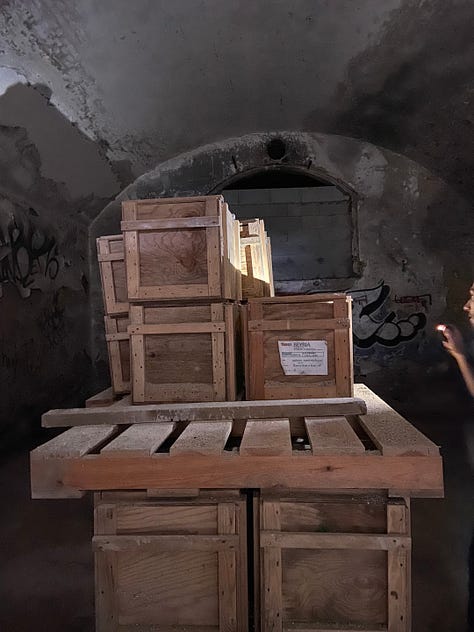
When this set of rooms exhausted itself, we wondered if we had seen the bulk of what there was to see. (Based on the absence of tagging in the areas we later discovered, perhaps that’s what most visitors think.) We poked around the leafy ditch between scarp and counterscarp walls, where we saw an opening into a narrow, skewing passageway, gothically framed by the exposed roots of a tree growing out of the bedrock into the twisted brick. It looked like a dead end, so we didn’t go in. If we had…well, you’ll see.


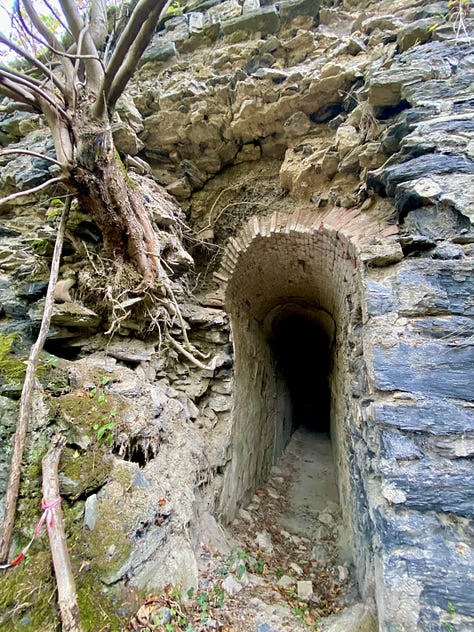
Instead, we followed the wall of the fort, smothered by trees and vines, to the opposite side of the courtyard. Here, a promising door stood open onto nothing; but there, in the corner, was the unlikely way in, the archway crossed with timbers. As before, the chicken wire had already been pulled back for us. I was first in this time, and found myself at the foot of a ceiling-high pile of rubble on one hand, and looking into a pitch-black archway on the other.
In the realm of green and yellow I had just left behind, the wind was picking up.

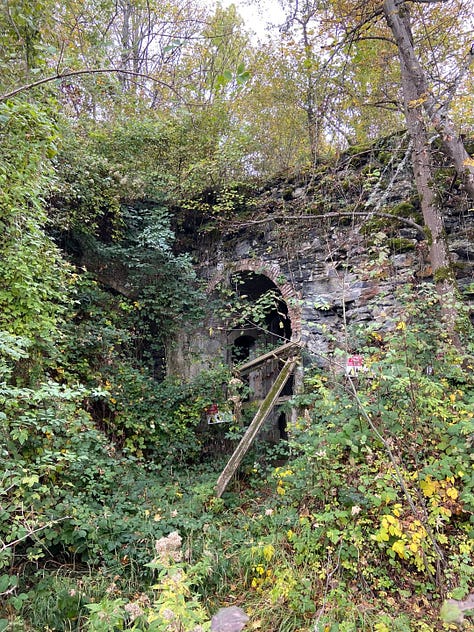
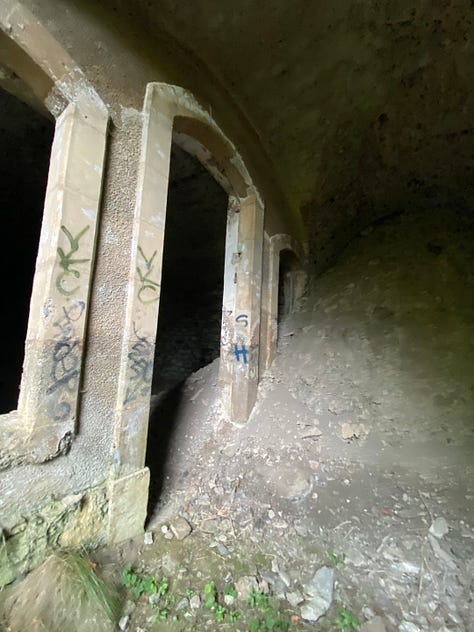
Matthias came in with his headlamp and revealed a large room with a peeling vaulted ceiling, empty except for some fallen blocks. A casemate, I called it. Despite the pile of rubble near the entrance, we judged the structure sound, and again wondered if such a hefty pile of dirt with no apparent source would have come from the Resistance explosion, a lifetime ago. So we wandered cautiously all the way to the back of the room where there was a strange, vaguely T-shaped opening that, with our depth of field, looked like another dead end.
In fact, it was a doorway. When we looked through, we saw a stony, claustrophobic corridor running perpendicular to us, arched supports receding as far as the headlamp could reveal in either direction, almost devoid of natural light except for a faint glimmer at one end.
And we had a decision to make.
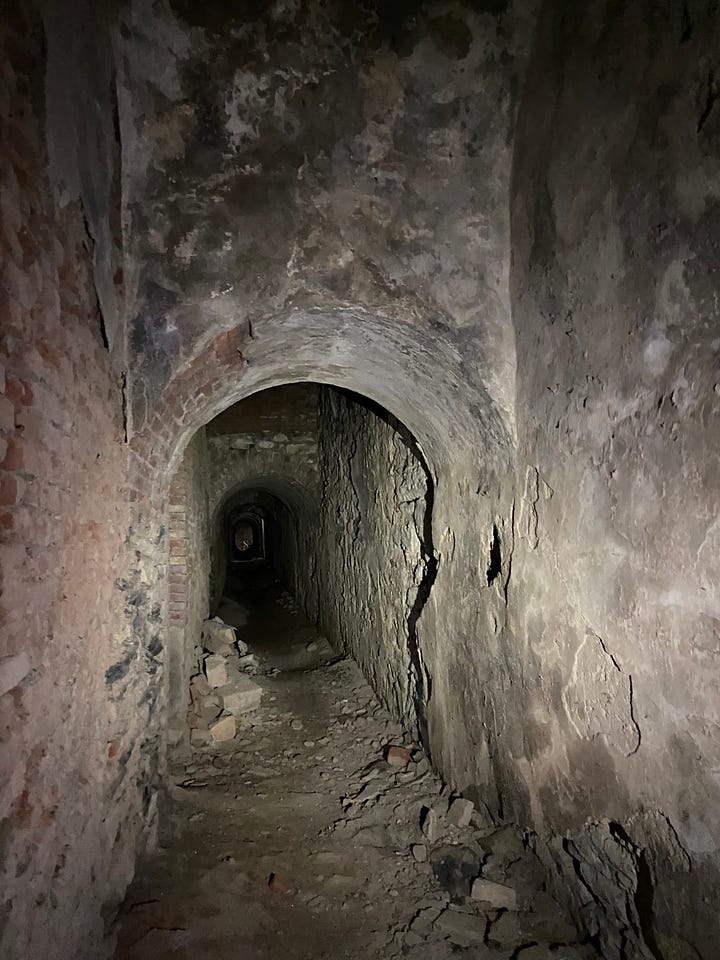
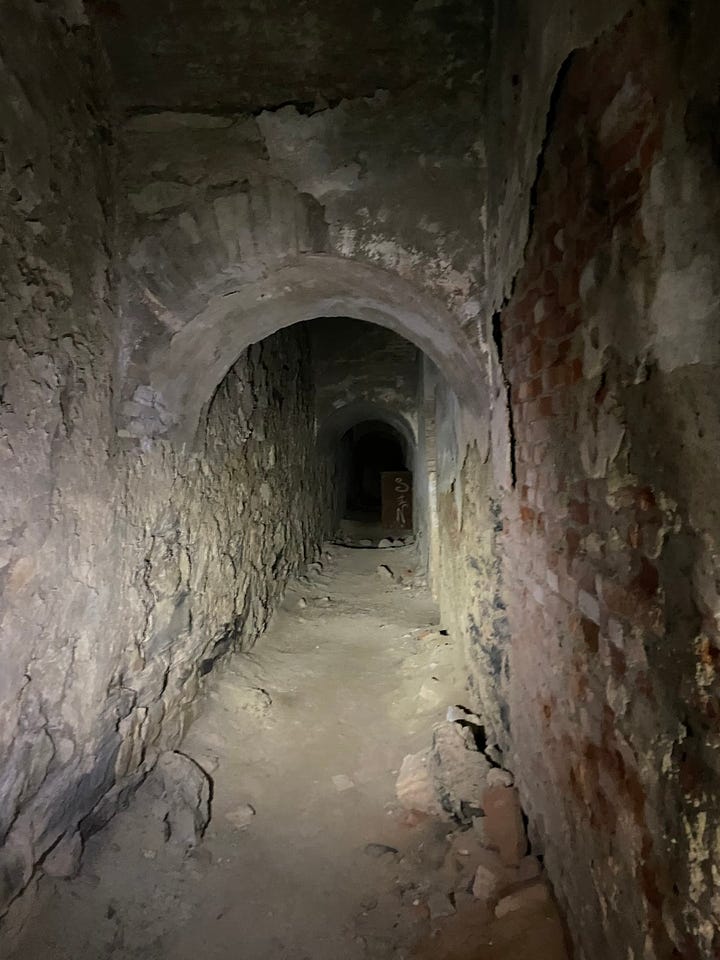
Here is where, without a doubt, I would have stopped if I were the sole decisionmaker. Marianne later said the same. But as a group, and perhaps especially thanks to Matthias, we were game. This is what we were here for, and if no one else was detecting enough risk to turn back, then it was probably fine.
So we went in. We chose a direction and walked down the corridor that any horror movie audience would know was a fatal mistake. But strangely, I was only mildly spooked. With friends and lights, and perhaps just the right amount of adrenaline, the place felt more or less like what it was: a decrepit but tranquil stone corridor in a hillside with an interesting history, the skirting darkness mostly an atmospheric inconvenience. The most immediate thing I was concerned about was falling rubble or collapsing walls, but even this seemed remote.
Honestly, I’m more spooked now, looking back through my phone photos, the murkiness and rubbly shadows brought into relief by the flash, staring back at me on a screen that blinks to sudden dimness, and then blackness, after I’ve let it stare for long enough.
The one clear moment of collective spook came when we paused at the doorway of one of the neighboring casemates that lined the corridor, and fell silent together as we heard the slightest shift above us and felt something tick down. We looked up and saw a long, black reach upward to faint points of light in a high ceiling: a ventilation shaft. We noted this with nervous laughs and went into the casemate.
Each casemate had its symmetrical arched doors and windows at the opposite wall, some letting in healthy light, and many partially blocked with those strange piles of rubble. We noticed the ground sparkling faintly in one and under the lamp saw what looked like encrusted salt over brick and dirt. Eventually we located ourselves in a casemate that we had peered into from the very first passageway, too well-barred by metal doors to enter there, but perfectly open on this end. Here were mysterious concrete cradles, seemingly too new for 19th-century artillery, so perhaps for equipment from the laboratory days.
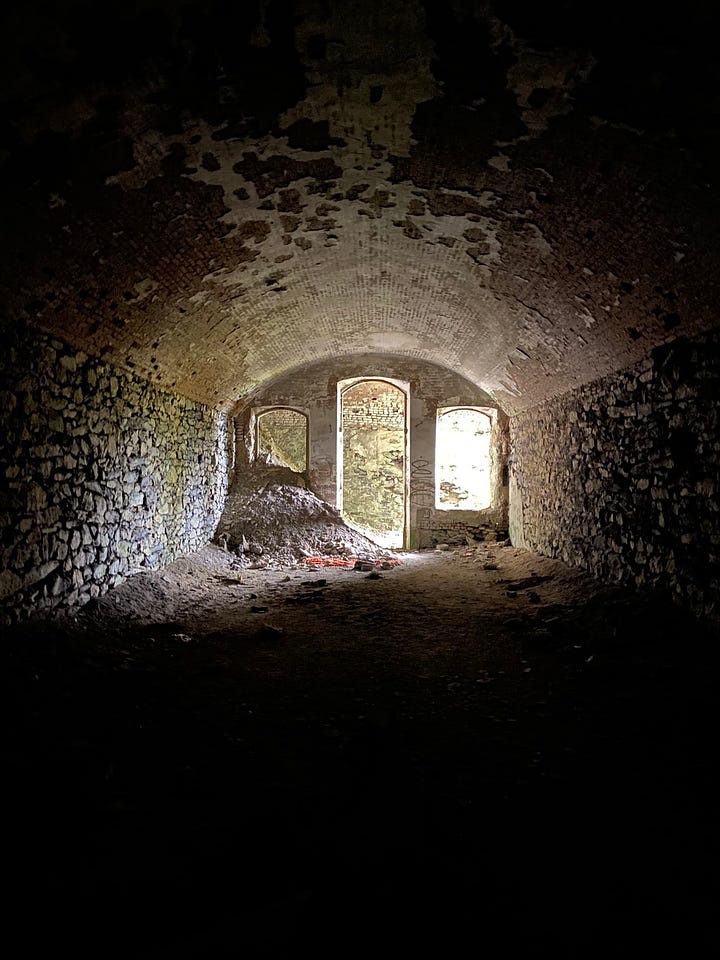
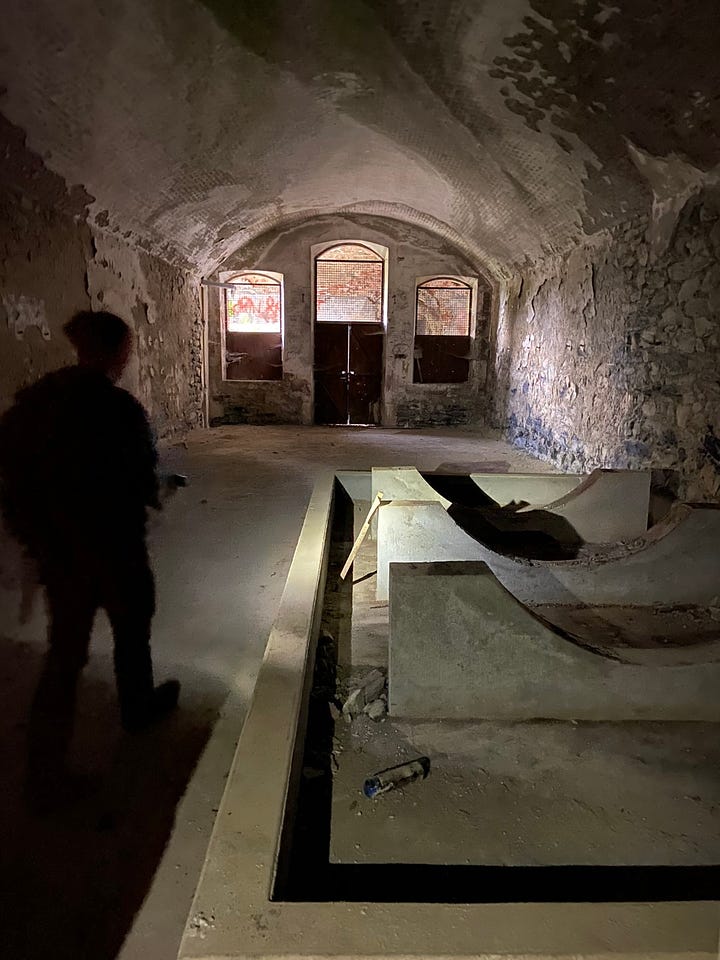
Just beyond this casemate was the glimmer of light we had seen at the end of the tunnel: the back wall of the tree-root passageway we had thought was a dead end. What would it have been like to come to this blackness from under that tree?
We turned back to scope out the righthand stretch of the corridor, determined to be thorough. More identical casemates, though more rubbled the closer we got to the end. We had passed by some dim flights of stairs, and after we had visited every casemate on the bottom floor, we returned to the stairs. Matthias accessed them through a rusted door standing open into the corridor, but Marianne and I felt superstitious and took the roundabout opening that didn’t require us to stoop.
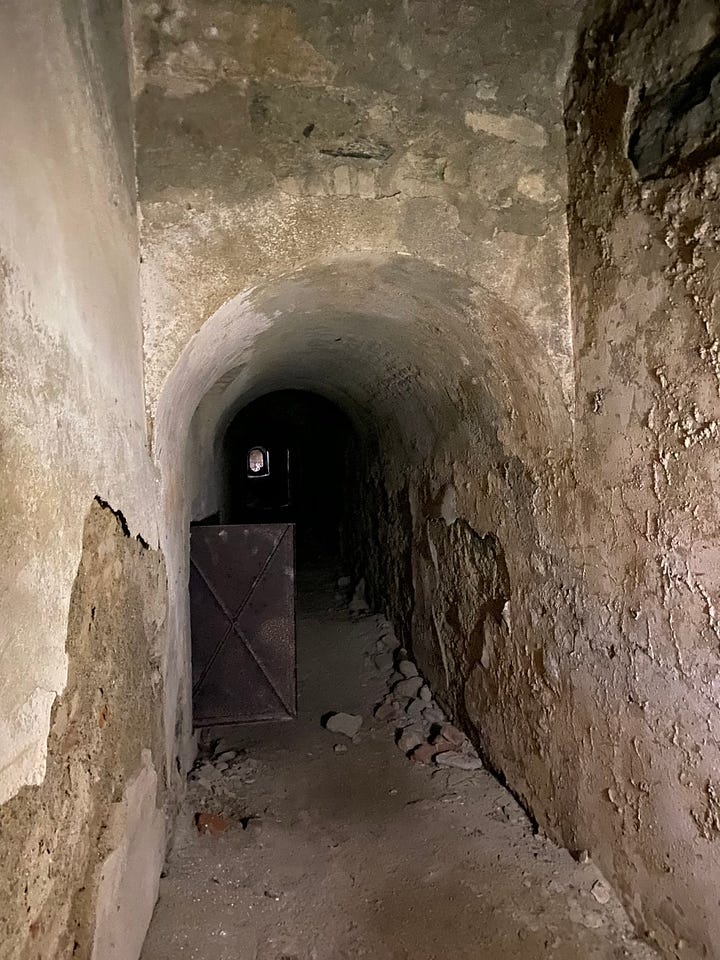
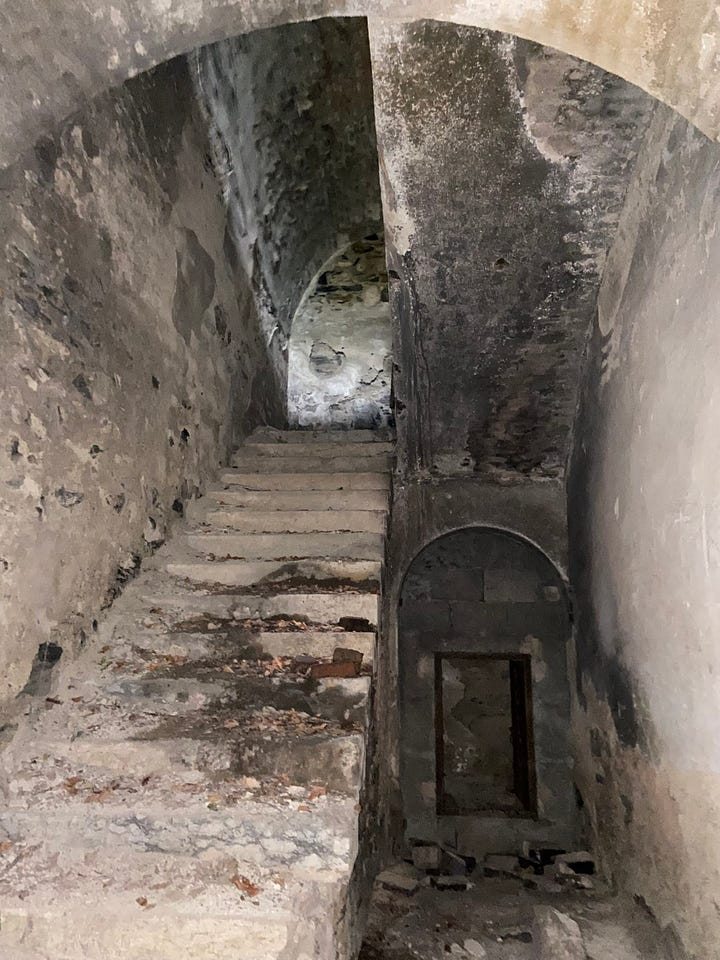
The stairs were crumbling at the edges, and here was another point where my natural caution would have kept me on the ground. But there was no real reason to think they weren’t solid, and indeed, they held us. However, the upper floor was a disappointment compared to the bounty of continuous darkness we had discovered below; any passage between chambers had been blocked off and we had only a vegetation-choked opening to peer out of at the top of the flight. I did capture a photo of a bricked-up stairwell that Matthias’s headlamp’s red-light mode rendered into a perfectly delicious apparition.
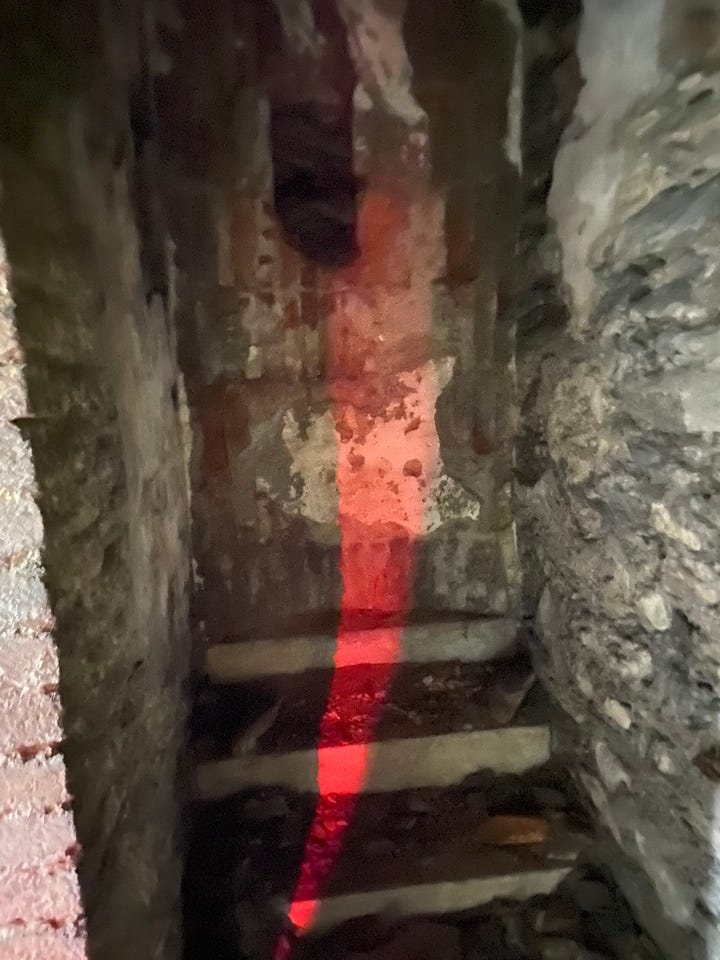
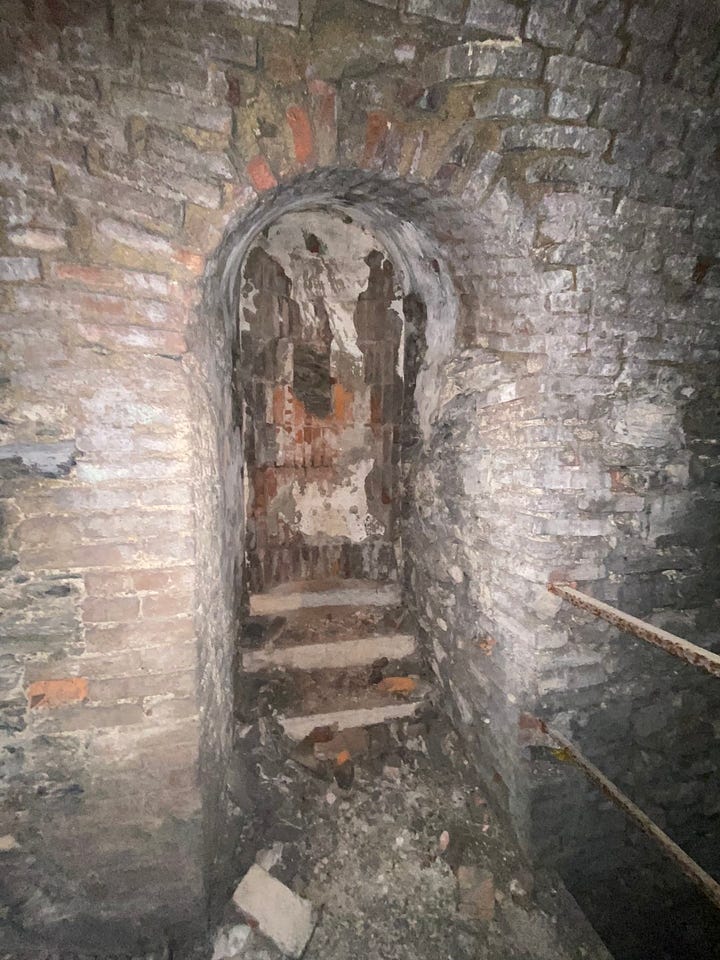
As we squeezed through the chicken wire back into the living world, we saw a young couple in brightly colored athletic wear approaching, the only encounter with others during our whole exploration. I was glad for the timing, out in the light, after the darkness, and for the ease of exchanging a friendly word of encouragement. Hearing unknown others with us somewhere in the dark would have been a different ballgame.
Our last frontier was the top of the fort, accessible by an obliging metal stairway onto the wooded hilltop. We didn’t know that there would be much to see besides the trees creaking in the now voluble wind. But after we had found the apparent summit, a square of concrete on a little rise, and contemplated whether falling branches would in fact become the biggest risk we would face today, we followed the faint trail a little further and saw the terrace that was the roof of the entry building. It was ringed with graffiti and a bracing navy-and-white view of the nearest mountains. We sat there on the cold concrete among the weeds and old rusted nails and ate our lunches.
On our way out, we found one of the air vents that had given us that little greeting down there in the dark. A couple of uneven chinks in the concrete.
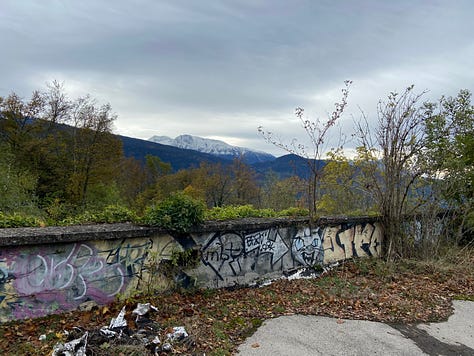
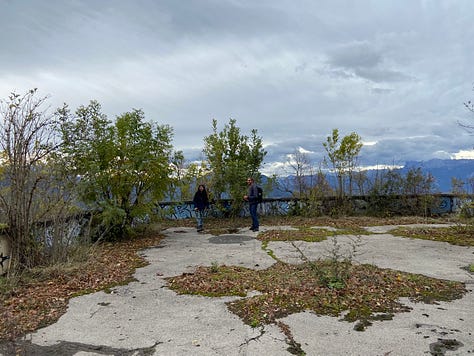
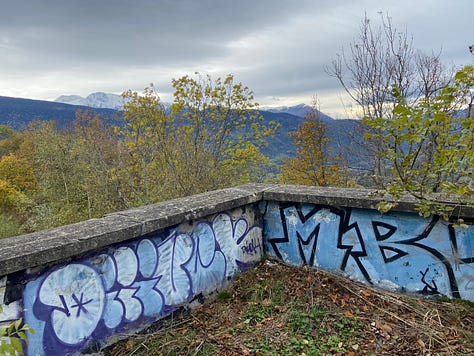
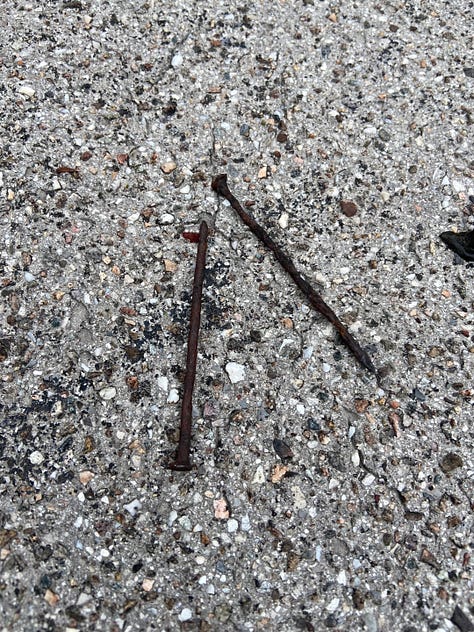
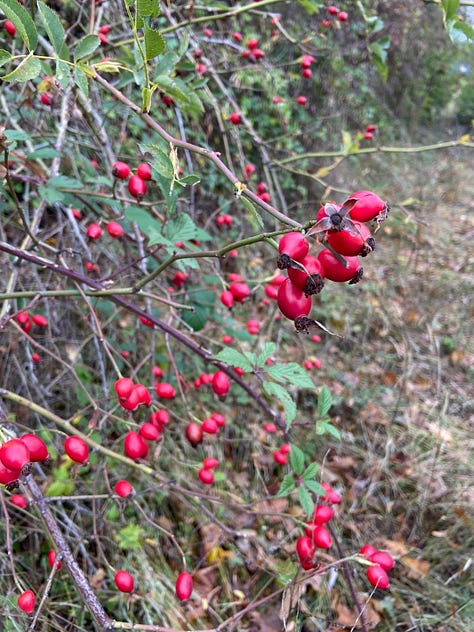

We had planned to hike another few hours to the other abandoned fort on a neighboring hill, Fort de Montavie. But an hour and half into our rural ballade—which, despite the continued edge of melancholy to the weather, was actually quite idyllic—it started to rain. Already satisfied (thrilled, in fact) with the day’s discoveries, we bailed out at the base of Montavie’s hill and took the bus into town for some gaufres with chocolate and Chantilly cream. And we were intact.
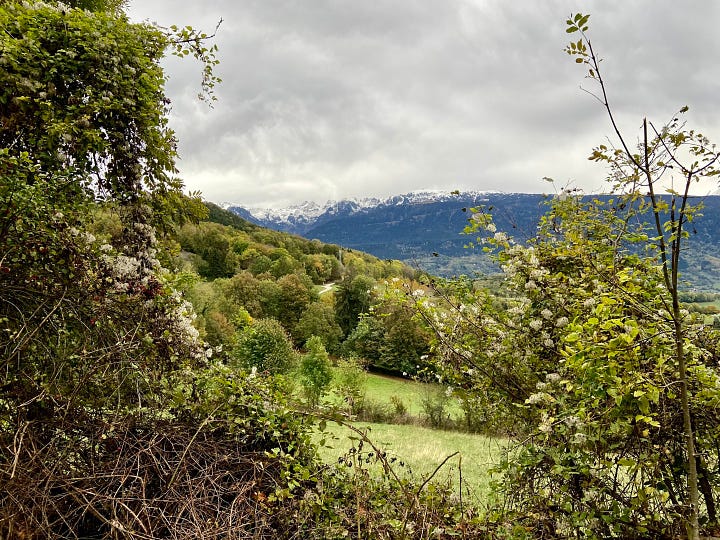

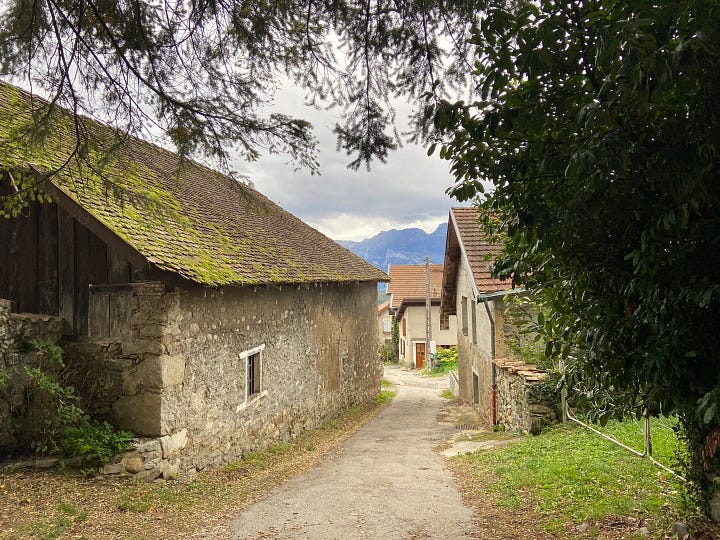
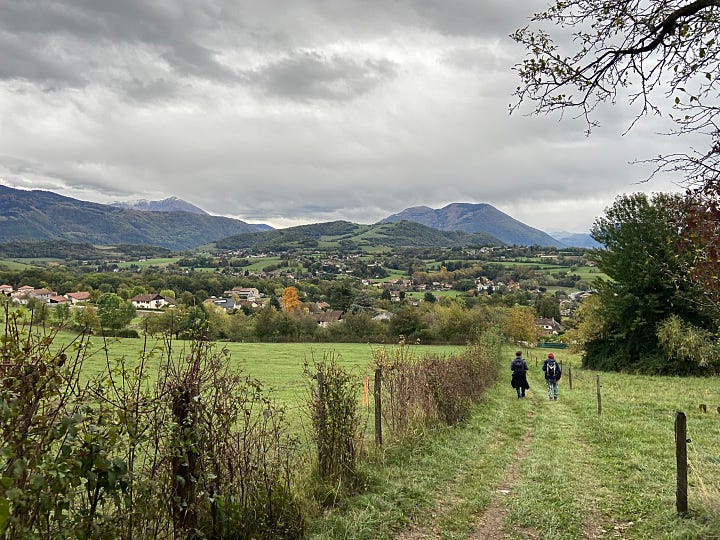
Unlike my first fort visit, reading ahead had given me a backstory, a pre-impression to fill in with the physical experience of Fort des Quatre Seigneurs. Even so, I found on revisiting the webpage that we hadn’t been curious enough, after all. We had not in fact found the explosion site of the Resistance incursion, the one that had blown the German soldiers to bits. Those bared internal arches, that missing wing, were tucked away somewhere on a plane of the fort we hadn’t discovered. The piles of rubble may well have been the backside of the impact, but they could have also simply been more signs of depollution pyrotechnique.
Despite my interest in the story, and perhaps in service of keeping my head, I also didn’t think very deeply about the past in those dark corridors. While I generally don’t see much in ghost stories beyond entertainment or making sense of the unexplainable, and certainly didn’t see any apparitions (besides the inadvertent creativity of my camera’s exposure), it’s easy to fill in the blank: such a place would be haunted by dead soldiers, if by anyone. And at such a time of year, too, “when the fabric between worlds is thin as tissue and easily torn.”2
But I didn’t think about them while I was in there. I didn’t even think much about the soldiers who had slept in the barracks or the scientists who had done whatever they did with magnetometry or whatever it was before the walls were covered in graffiti and plaster littered the floor.
As it turned out, my layer of experience would be with the physical. It was topology and the border between light and darkness and the sound of the wind. It took all my senses to meet the challenge of such an unwelcoming place, one that was nevertheless waiting quietly to divulge itself—at least the layers that currently meet the air.
Waiting, that is, if you find a way in, and choose to take it.
My friend lent me a coffee table book full of photos taken by urban explorers (Urbex: le monde oublié), and it was a tour de force of silent rusting railyards, decaying factories strewn with detritus of machinery, figures standing high on forbidden scaffolding inside a vast warehouse or under the dome of a defunct reactor, eerily preserved control rooms from 1940s electrical plants, castles with rotting floors, baroque chapels covered in graffiti, the dim receding wormholes of sewer systems and catacombs, the symmetries of prison yards and forgotten staircases. The authors explicitly “don’t give a disclaimer” about the illegality of their activities (which is in itself something of a disclaimer), and revel in the details of how difficult guarded spaces were to access or how many attempts it took them (though no details that identify how to access the places yourself). They don’t come across as total adrenaline junkies or rebels; they also style themselves as artists, history- and architecture-lovers, and simply (insatiably) curious, attitudes they encourage in their readers. “L’urbex…c’est un etat d’esprit.”
Louise Erdrich, The Sentence





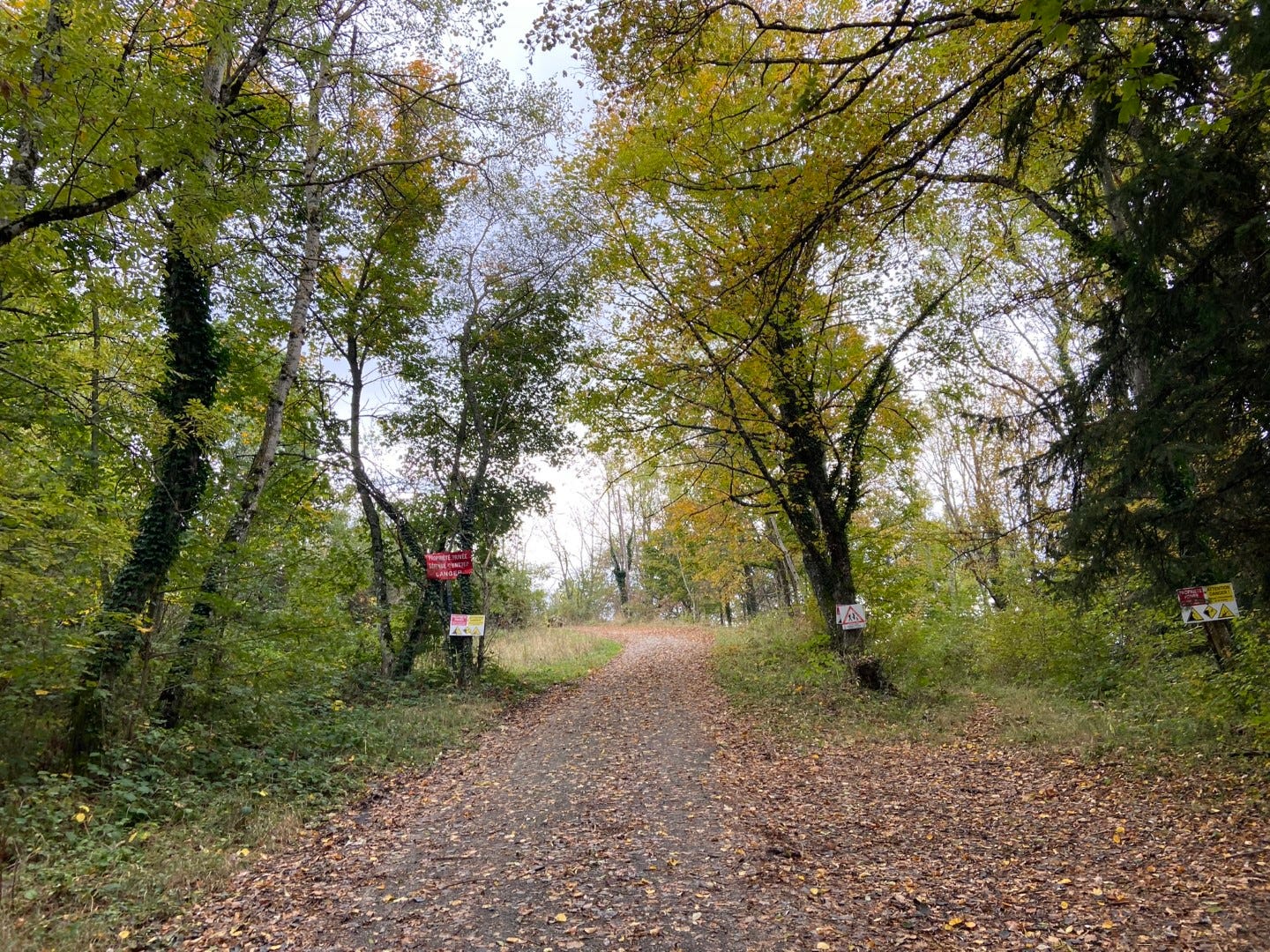
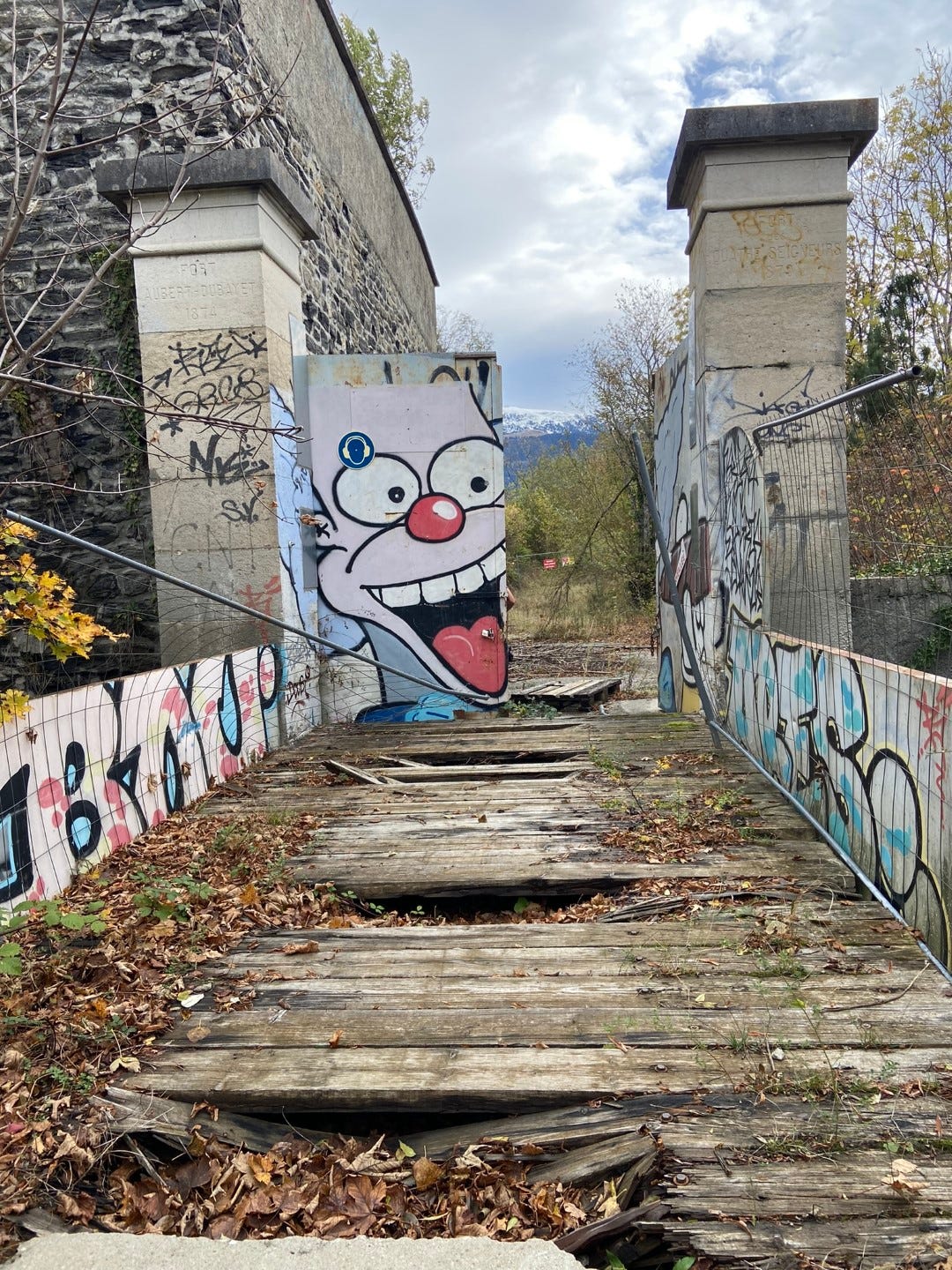
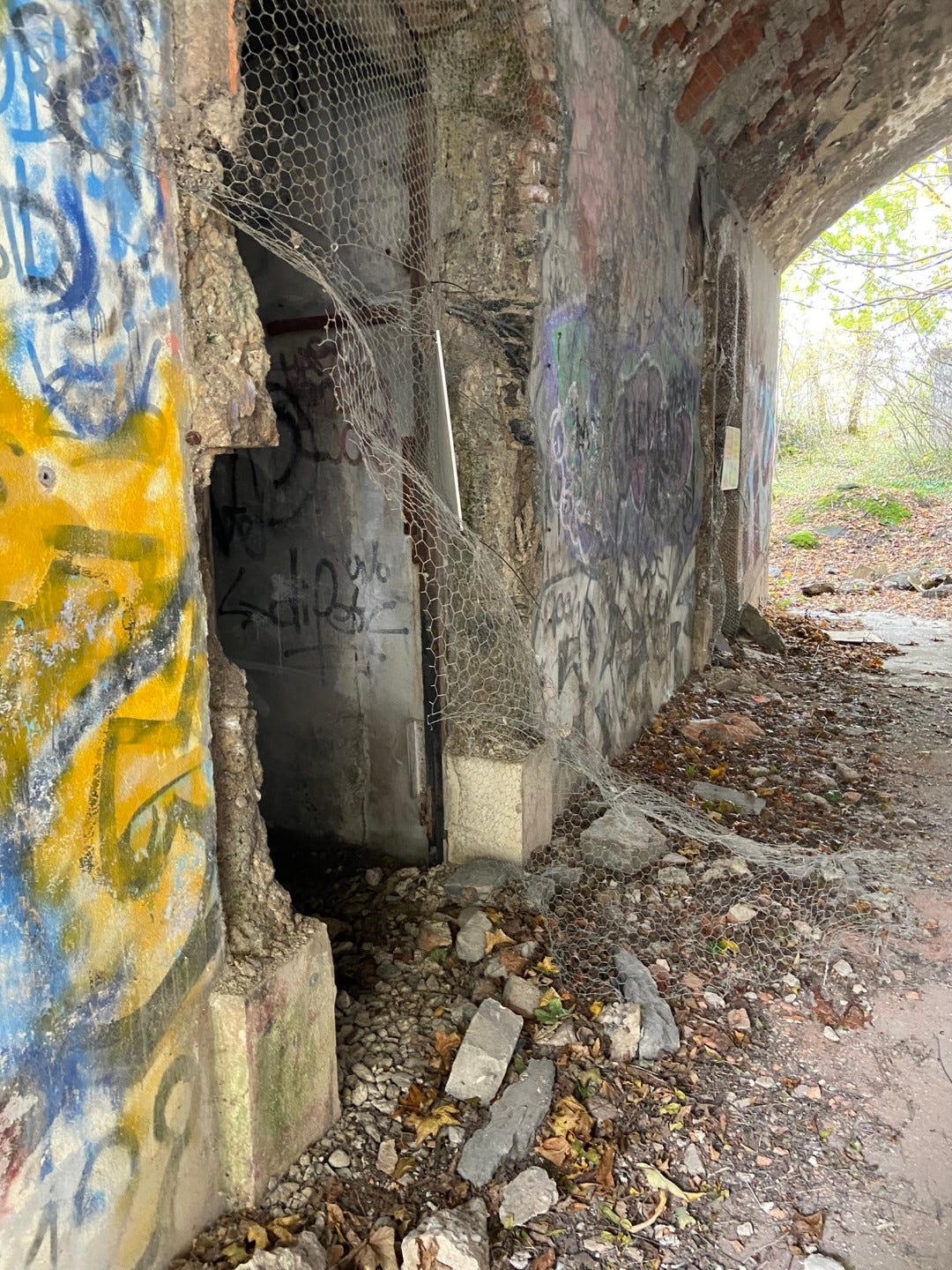
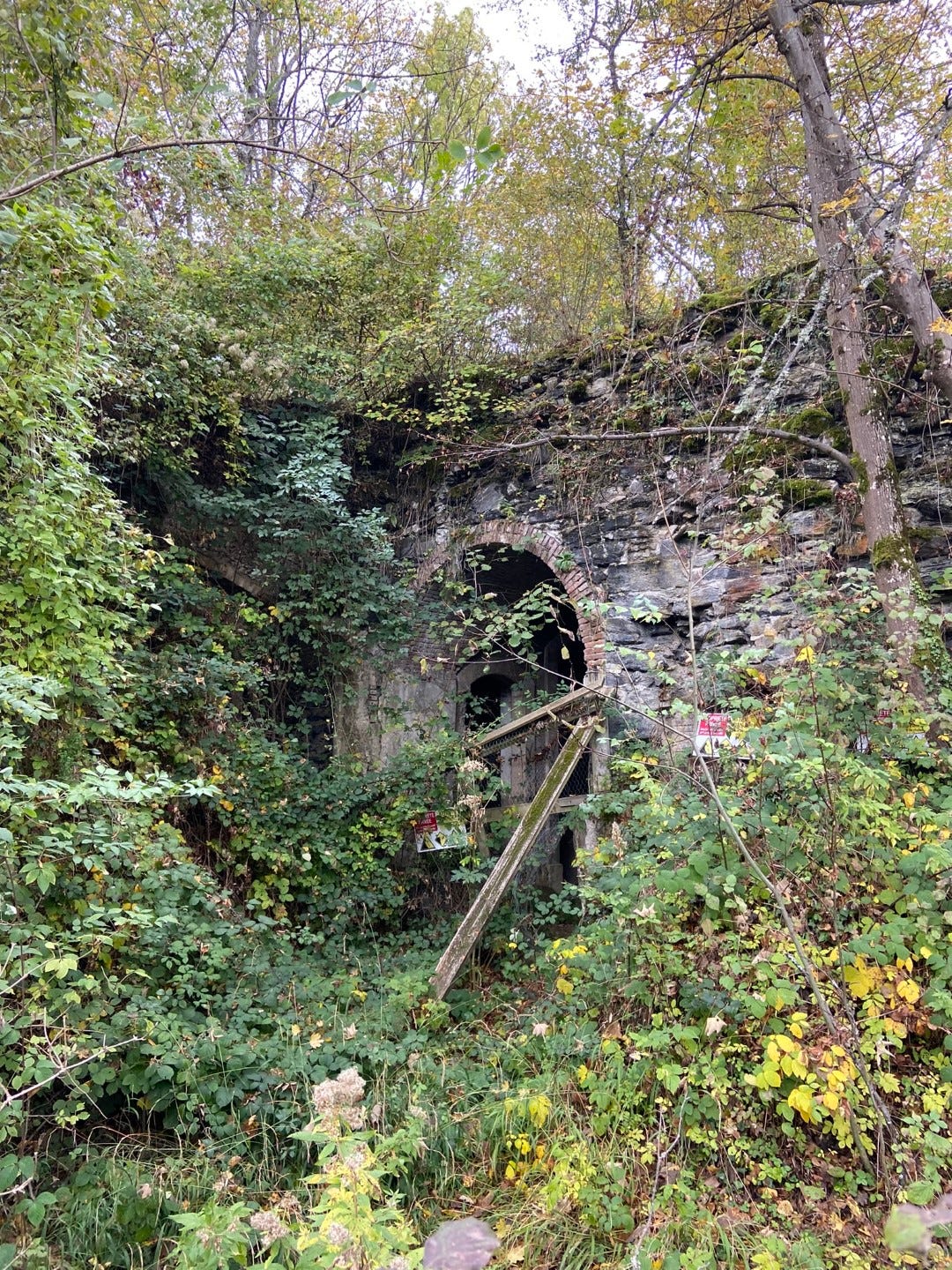
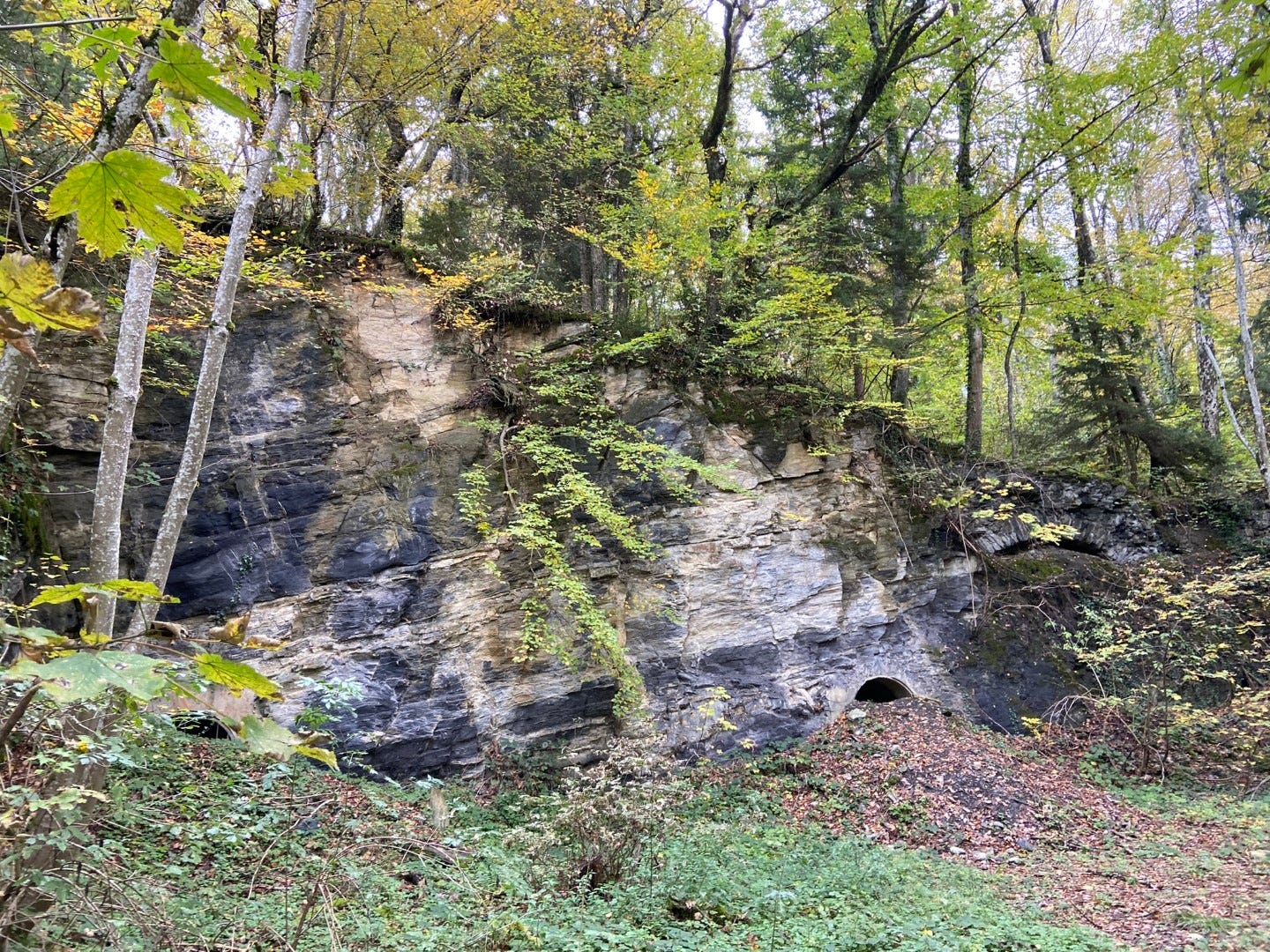
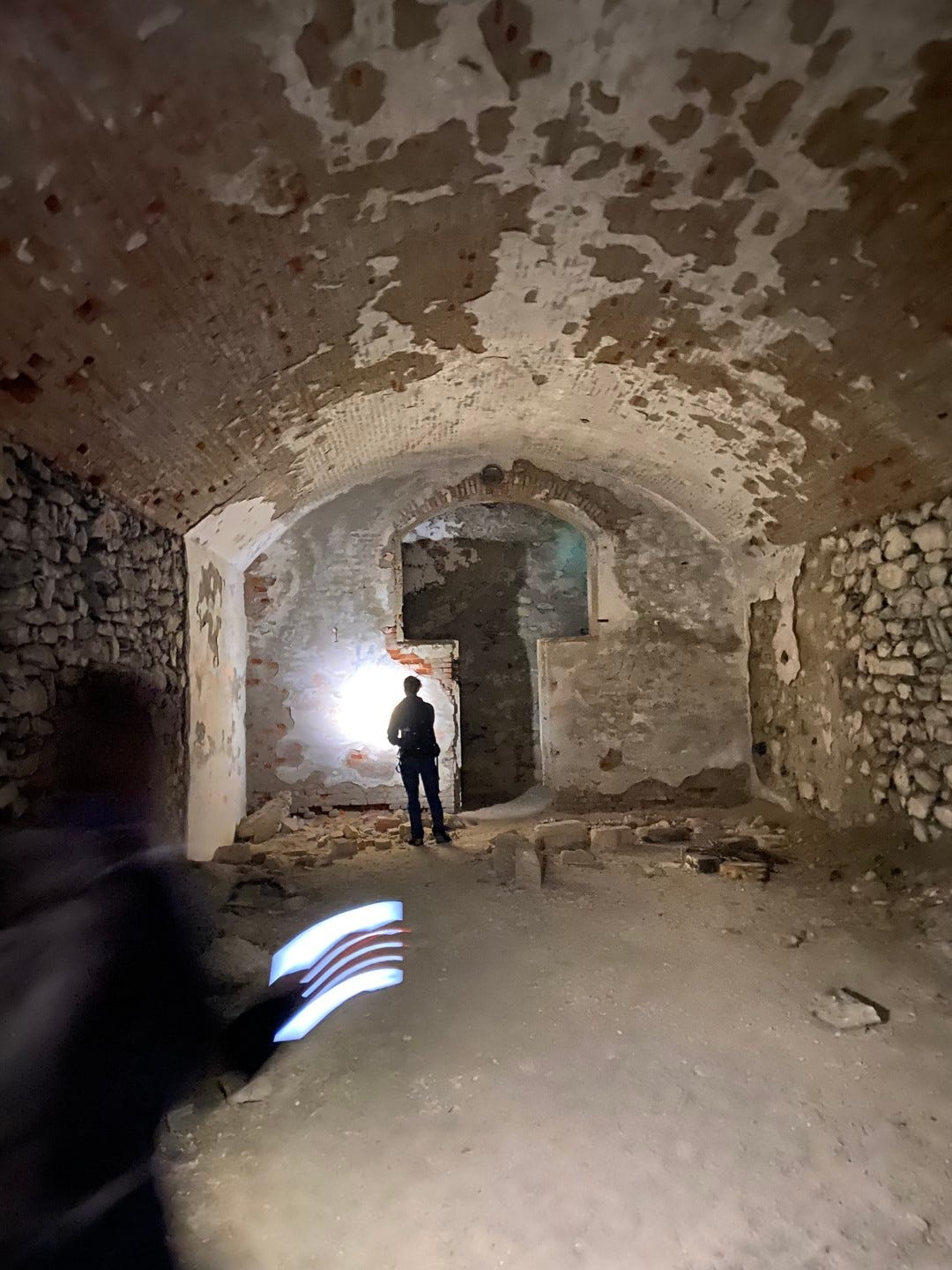
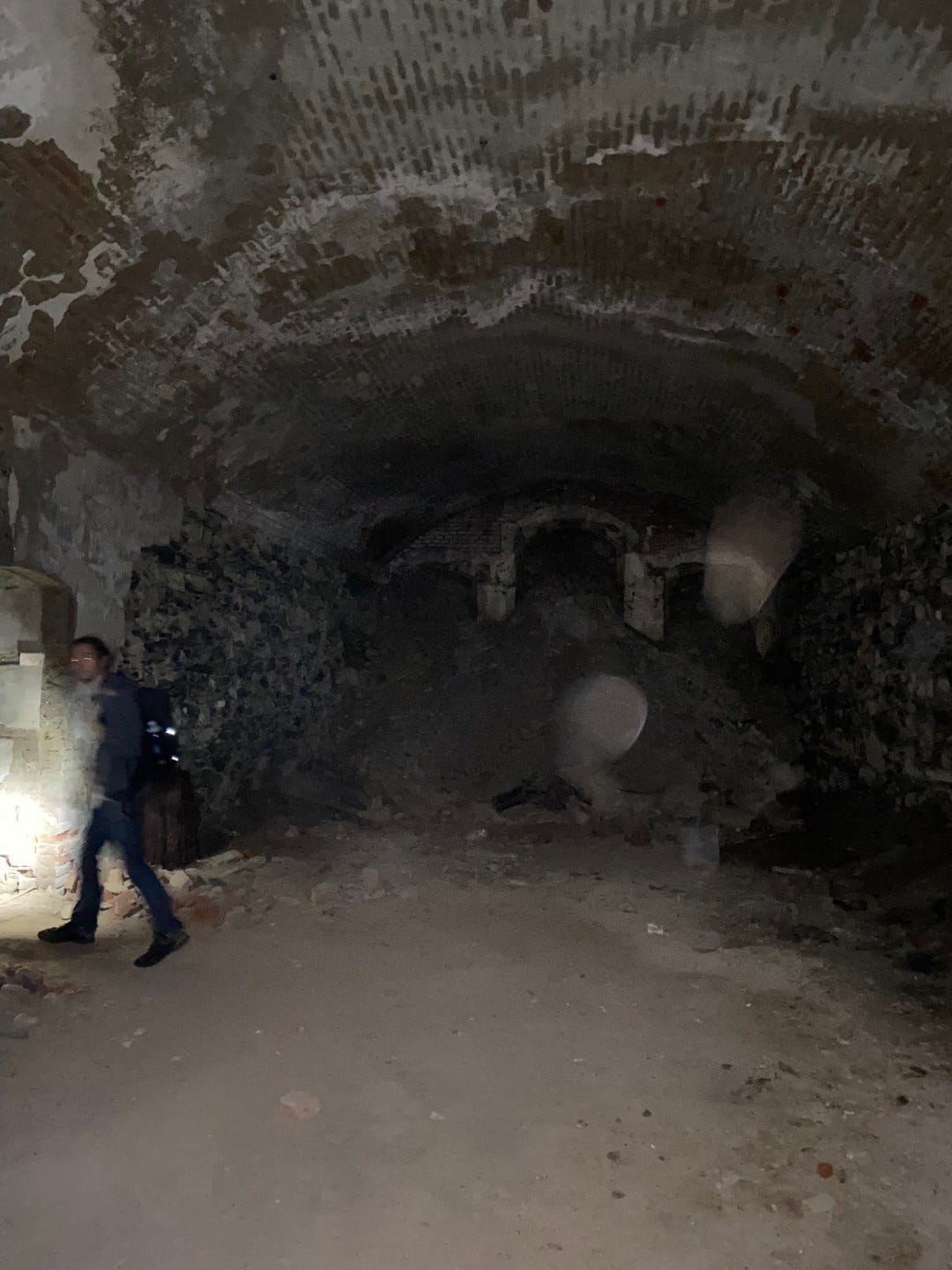
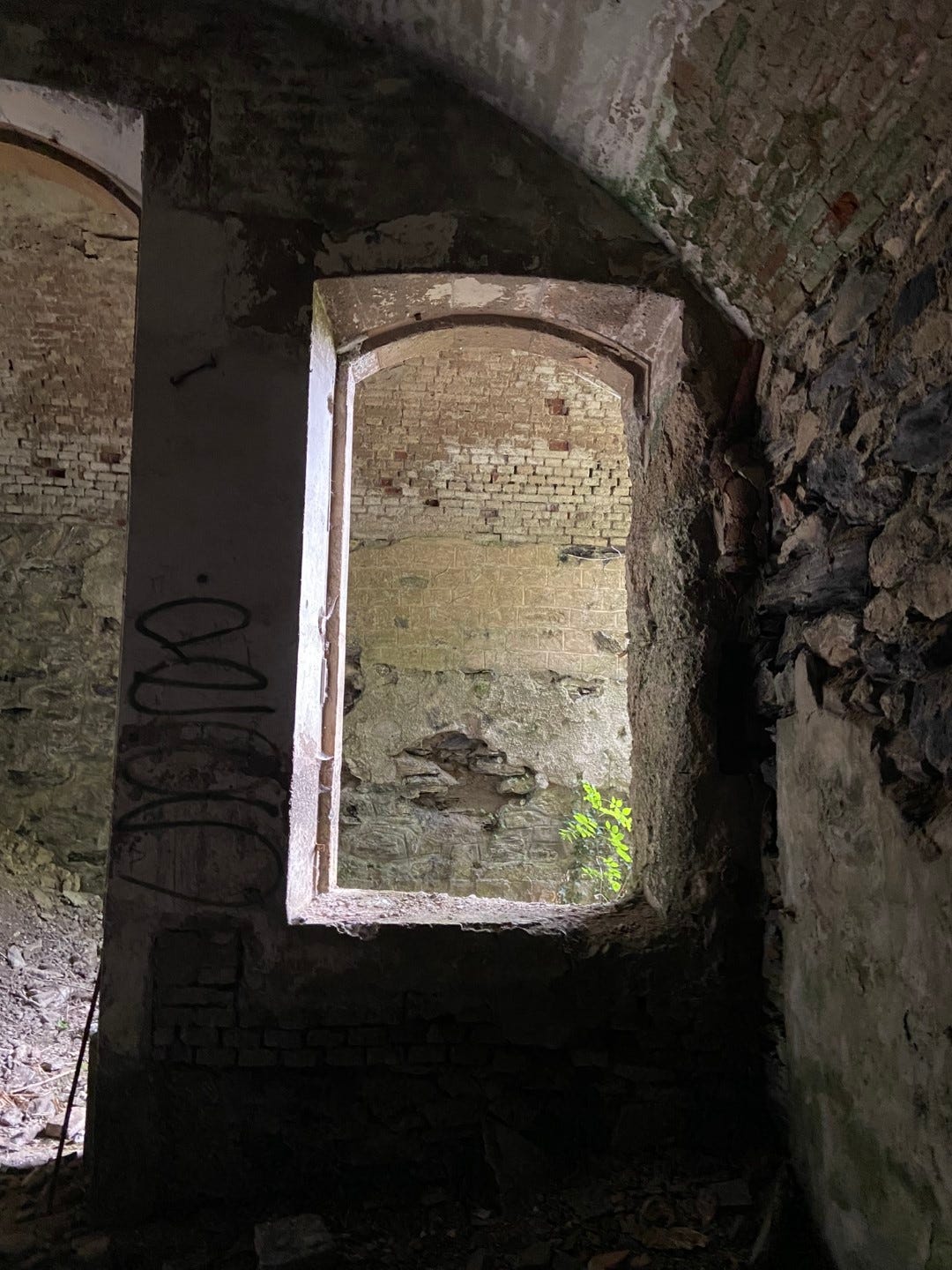
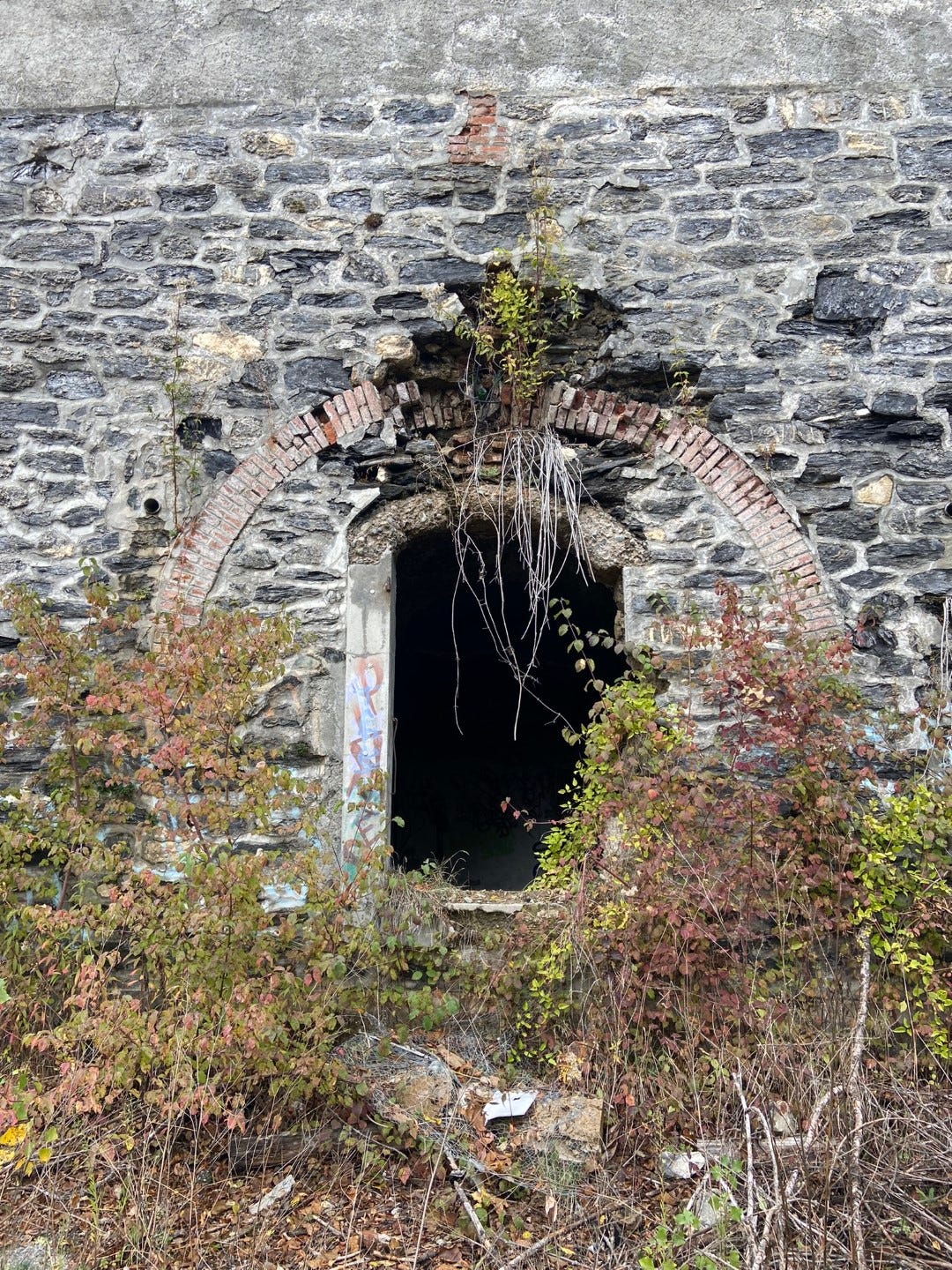
What an interesting foray, Anne. I admire your bravery. Urbex is a new word for me.
I'm also excited by abandoned places, mostly in finding beauty in decay rather than being inclined to get an adrenaline rush due to trespassing. Delighted you came away in one piece, with some great photos, and a brilliantly written story!